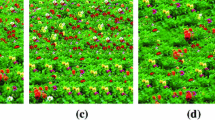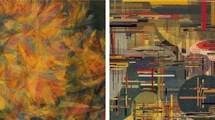Abstract
Salient structural elements are ubiquitous in natural textures, and their distribution exhibits some stochastic distribution features. Current texture synthesis algorithms can neither preserve the integrity of the elements nor capture this distributive information. We present an algorithm to treat this high-level visual information. Here, we address the issue by taking specific care of the structural elements. Our texture synthesis process grows the target texture one structural element at a time. A Markov random field model is assumed for the distribution of the salient structural elements. In the analysis process, the salient structural elements are first extracted, and their topological relationship is constructed. Next, in the synthesis process, to identify an unknown element with neighbors synthesized, we query the sample texture and find the most similar neighbor. The randomness of the target texture can be improved by randomly transforming the structural elements. Experimentation shows that our results pass scrutiny by the high-level visual processing of humans.
Similar content being viewed by others
References
Itti L, Koch C, Niebur E. A model of saliency-based visual attention for rapid scene analysis. IEEE Trans Patt Anal Mach Intell, 1998, 20: 1254–1259
Palmer S. Vision Science: Photons to Phenomenology. Cambridge, MA: MIT Press, 1999
Kwatra V, Schödl A, Essa I, et al. Graphcut textures: image and video synthesis using graph cuts. In: Proceedings of ACM SIGGRAPH 2003. New York: ACM Press, 2003. 277–286
Witkin A, Kass M. Reaction-diffusion textures. Comput Graph, 1991, 25: 299–308
Worley S P. A cellular texture basis function. In: Proceedings of ACM SIGGRAPH 1996. New York: ACM Press, 1996. 291–294
Dorsey J, Edelman A, Legakis J, et al. Modeling and rendering of weathered stone. In: Proceedings of ACM SIGGRAPH 1999. York: ACM Press, 1999. 225–234
Zhu S C, Wu Y, Mumford D. Filters, random fields and maximum entropy (frame). Int J Comput Vision, 1998, 27: 1–20
Efros A A, Leung T K. Texture synthesis by non-parametric sampling. In: Proceedings of ICCV 1999. Washington D C: IEEE Computer Society Press, 1999. 1033–1038
Wei L Y, Levoy M. Fast texture synthesis using tree-structured vector quantization. In: Proceedings of ACM SIGGRAPH 2000. New York: ACM Press, 2000. 479–488
Lefebvre S, Hoppe H. Parallel controllable texture synthesis. ACM Trans Graph, 2005, 24: 777–786
Michael A. Synthesizing natural textures. In: Symposium on Interactive 3D Graphics. New York: ACM Press, 2001. 217–226
Wu Q, Yu Y Z. Feature matching and deformation for texture synthesis. In: Proceedings of ACM SIGGRAPH 2004. New York: ACM Press, 2004. 364–367
Lefebvre S, Hoppe H. Appearance-space texture synthesis. In: Proceedings of ACM SIGGRAPH 2006. New York: ACM Press, 2006. 541–548
Efros A A, Freeman W T. Image quilting for texture synthesis and transfer. In: Proceedings of ACM SIGGRAPH 2001. New York: ACM Press, 2001. 341–346
Zhang J, Zhou K, Velho L, et al. Synthesis of progressively-variant textures on arbitrary surfaces. ACM Trans Graph, 2003, 22: 295–302
Liu Y, Lin W C, Hays J. Near-regular texture analysis and manipulation. ACM Trans Graph, 2004, 23: 368–376
Dischler J M, Maritaud K, Levoy B, et al. Texture particles. In: Proceedings of EUROGRAPHICS 2002. Aire-la-Ville: Eurographics Association Press, 2002. 401–410
Shen J B, Jin X G, Mao X Y, et al. Completion-based textures design using deformation. Visual Comput, 2006, 22: 936–945
Hertzmann A, Jacobs C E, Oliver N, et al. Image analogies. In: Proceedings of ACM SIGGRAPH 2001. New York: ACM Press, 2001. 327–340
Kwatra V, Essa I, Bobick A, et al. Texture optimization for example-based synthesis. In: Proceedings of ACM SIGGRAPH 2005. New York: ACM Press, 2005. 795–802
Wei L Y, Han J W, Zhou K, et al. Inverse texture Synthesis. ACM Trans Graph, 2008, 27: 1–9
Telea A. An image inpainting technique based on the fast marching method. J Graph Tools, 2004, 9: 23–24
Cheng M M, Zhang F L, Mitra N J, et al. RepFinder: Finding approximately repeated scene elements for image editing. ACM Trans Graph, 2010, 29: 1–8
Cover T M, Thomas J A. Elements of Information Theory. New York: Wiley-Interscience, 1991
Deussen O, Hanrahan P, Pharr M, et al. Realistic modeling and rendering of plant ecosystems. In: Proceedings of SIGGRAPH 1998. New York: ACM Press, 1998. 275–286
Author information
Authors and Affiliations
Corresponding author
Rights and permissions
About this article
Cite this article
Pan, B., Zhong, F., Wang, S. et al. Salient structural elements based texture synthesis. Sci. China Inf. Sci. 54, 1199–1206 (2011). https://doi.org/10.1007/s11432-011-4246-3
Received:
Accepted:
Published:
Issue Date:
DOI: https://doi.org/10.1007/s11432-011-4246-3




